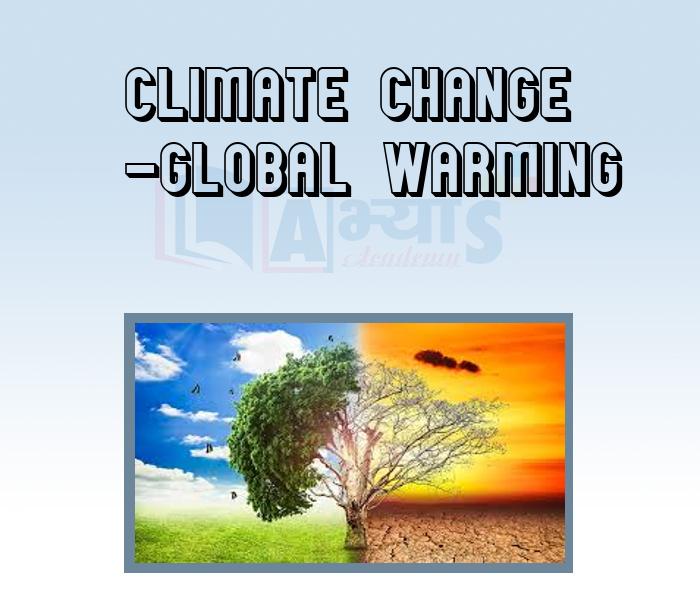Climate Change -Global Warming












Climate Change -Global Warming
Global Warming: The term "global warming" is a specific example of climate change, which can also refer to global cooling. In common usage, the term refers to recent warming and implies a human influence. The United Nations Framework Convention on Climate Change (UNFCCC) uses the term "climate change" for human-caused change, and "climate variability" for other changes. The Intergovernmental Panel on Climate Change (IPCC) concludes, "most of the observed increase in globally averaged temperature since the mid-twentieth century is very likely due to the observed increase in anthropogenic greenhous gas concentrations." Climate model projections summarised by the IPCC indicate that average global surface temperature will likely rise a further 1.1°C to 6.4°C (2.0°F to 11.5°F) during the twenty-fint century. The range of values results from the use of differing scenarios of future greenhouse-gas emissione as well as models with differing climate sensitivity.
What is Global Warming: Global warming is the increase in the average temperature of the Earth's near-surface air and oceans in recent decades and its projected continuation. The global average air temperature near the Earth's surface increased o.74 + 0.18 °C (1.33 + 0.32 °F) during the hundred years ending in 2005. Although most studies focus on the period up to 2100, warming and sea level rise are expected to continue for more than a thousand years even if greenhouse gas levels are stabilised. The delay in reaching equilibrium is a result of the large heat capacity of the oceans. Increasing global temperature will cause sea level to rise, and is expected to increase the intensity of extreme weather events and to change the amount and pattern of precipitation. Other effects of global warming include changes in agricultural yields, trade routes, glacier retreat, species extinctions and increases in the ranges of disease vectors.
Causes of Global Warming: The detailed causes of the recent warming remain an active field of research, but the scientific consensus is that the increase in atmospheric greenhouse gases due to human activity caused most of the warming observed since the start of the industrial era. Some other hypotheses departing from the consensus view have been suggested to explain the temperature increase. One such hypothesis proposes that warming may be the result of variations in solar activity.
Students / Parents Reviews [10]
Being a parent, I saw my daughter improvement in her studies by seeing a good result in all day to day compititive exam TMO, NSO, IEO etc and as well as studies. I have got a fruitful result from my daughter.

Prisha Gupta
8thI have spent a wonderful time in Abhyas academy. It has made my reasoning more apt, English more stronger and Maths an interesting subject for me. It has given me a habbit of self studying

Yatharthi Sharma
10thMy experience with Abhyas is very good. I have learnt many things here like vedic maths and reasoning also. Teachers here first take our doubts and then there are assignments to verify our weak points.

Shivam Rana
7thOne of the best institutes to develope a child interest in studies.Provides SST and English knowledge also unlike other institutes. Teachers are co operative and friendly online tests andPPT develope practical knowledge also.

Aman Kumar Shrivastava
10thAbhyas Methodology is very good. It is based on according to student and each child manages accordingly to its properly. Methodology has improved the abilities of students to shine them in future.

Manish Kumar
10thAbout Abhyas metholodology the teachers are very nice and hardworking toward students.The Centre Head Mrs Anu Sethi is also a brilliant teacher.Abhyas has taught me how to overcome problems and has always taken my doubts and suppoeted me.

Shreya Shrivastava
8thIt was good as the experience because as we had come here we had been improved in a such envirnment created here.Extra is taught which is beneficial for future.

Eshan Arora
8thMy experience with Abhyas academy is very good. I did not think that my every subject coming here will be so strong. The main thing is that the online tests had made me learn here more things.

Hiya Gupta
8thA marvelous experience with Abhyas. I am glad to share that my ward has achieved more than enough at the Ambala ABHYAS centre. Years have passed on and more and more he has gained. May the centre flourish and develop day by day by the grace of God.

Archit Segal
7thIt has a great methodology. Students here can get analysis to their test quickly.We can learn easily through PPTs and the testing methods are good. We know that where we have to practice
